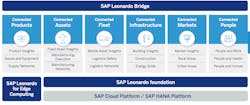The Internet of Things (IoT) is more than a collection of devices sharing data. In order to have a successful IoT deployment, companies must consider many aspects including how to connect business processes, how to turn data into intelligent information and how to adapt people to a new way of working. Just as important is knowing where and how to start.
Understanding the need for the end-to-end digital transformation that is required to connect intelligent devices with people and processes, SAP earlier this month announced the Leonardo innovation portfolio. Built on top of the SAP HANA in-memory platform for processing high volumes of data in real-time, Leonardo is a suite of products and services including IoT applications, business services for development, technical services for processing high-velocity data and an intelligent edge for information at the device level.
According to SAP officials, Leonardo is the foundation for a new strategy that SAP revealed in September with the announcement that the company is investing $2.2 billion in IoT products and acquisitions. The name itself is representative of a pioneering effort.
“Leonardo is a reference to da Vinci, innovative for his time across many broad fields and who changed the world,” said Hans Thalbauer, SAP’s senior vice president of extended supply chain and IoT. “IoT will do the same.”
Leonardo combines adaptive applications, Big Data management and connectivity across six categories that apply to the supply chain and manufacturing:
- Connected products for new insights into lifecycle management, sourcing, response and supply, and digital supply networks; and the design, manufacturing and delivery of smart, connected products across all industries.
- Connected assets to track, monitor and analyze fixed assets, including manufacturing and maintenance business processes, to reduce costs and increase equipment uptime.
- Connected fleet to enable businesses and public service organizations owning moving assets (such as vehicles, robots, fork lifts and autonomous vehicles) to improve services and safety, visibility to logistics and service quality.
- Connected infrastructure for new digital operational intelligence from physical-infrastructure systems, construction and energy grids enabling improved service, efficient operations and compliance and risk mitigation.
- Connected markets to enable new production, and business models of local relevance and at the right timing for customer and marketing insights, digital agribusiness, smart ports and smart cities.
- Connected people for more insightful, collaborative work roles, health management and smart home environments connecting people and communities and providing better, more personalized lifestyle experiences.
On top of all of these categories is the SAP Leonardo Bridge, which connects the adaptive applications with enterprise resource planning (ERP) and HANA. This is where the power to work differently comes in.
In asset management, for example, “we are not just providing predictive maintenance, but we have the possibility to connect to the ERP environment and to the plant environment,” Thalbauer said. “With the SAP Leonardo Bridge, users are able to make a financial decision in real time.”
Similarly, on the manufacturing side, a manufacturing execution system (MES) could connect back to material requirements planning (MRP) and the supply chain to increase productivity and support the personalization of products. Meanwhile, the Leonardo Foundation manages data and security aspects in the cloud and SAP Leonardo for Edge Computing ingests data regardless of connectivity, latency or device protocols to deliver intelligent edge applications.
“The purpose is to enable people to work differently. We have a solution which enables people to anticipate and solve issues before they happen,” Thalbauer said.
To that end, Leonardo changes the way people work by providing visibility where they never had it before. Typically, manufacturing is run off of reports—from yesterday. Or, if something happens on a production line, an operator may call a plant manager or a warehouse manager to expedite an order, for example. “That’s how decisions are made,” Thalbauer said, “but we want to use IoT to dramatically change that. We can provide an understanding at any given point in time of where things are in the business and then tie it into the financial information, like, what the options are if an order is late. This creates an environment that is dramatically different.”
Now that SAP is aligning all of the pieces in the IoT puzzle, the next question for customers is where—and how—to get started. For that, SAP announced its jump-start enablement program to help organizations identify and validate IoT pilots and use cases.
SAP line-of-business and industry experts engage with manufacturers in a multiphase project that matches IoT with customer strategies as a way to create a roadmap to achieve business value. After a three-month pilot project, the customer can decide whether to extend it to the enterprise.
Promotional pricing for the IoT jump-start is based on a fixed cost for software and services to cover the pilot and first year of usage of key areas within the SAP Leonardo IoT portfolio. This creates transparency and eliminates budget uncertainty enabling customers to establish IoT projects with a clear scope, length and pricing.
Companies in this Article
Leaders relevant to this article:

